September 2024
To Uproot
Racist Oppression: Socialist Revolution
Black Liberation –
Struggle and Strategy
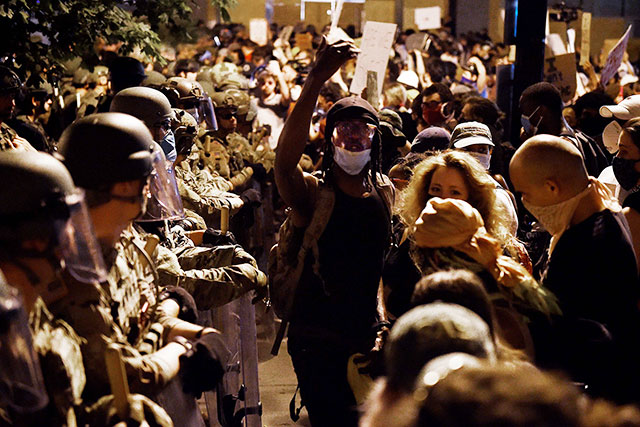
Demonstrators in Washington, D.C. on 3 June 2020 protesting racist police murder confront National Guard troops brought in from around the U.S. (Photo: AFP)
By Max and Rosario
Much of what characterizes the life of working-class youth in capitalist society today is uncertainty. Amidst this day-to-day reality, the fact that racist violence from the police is a never-ending danger was brought home to us unbearably yet again, on July 6, with the wanton murder of Sonya Massey, shot in the face by a deputy sheriff near Springfield, Illinois after she called 911, believing a would-be intruder was near her home.
Four years after the mass protests of 2020, racist police terror continues unabated. In 2023, according to figures compiled by the website mappingpoliceviolence.us, police killed at least 1,247 people, more than in 2020 – or any other year in more than a decade. Now in 2024, the site states, police are killing people at an even higher rate (721 as of early August) – and black people are three times as likely as white people to be killed by the cops.
While liberals pretended that the election of Barack Obama heralded the United States becoming a “post-racial society,” revolutionary Marxists underline that racial oppression is woven into the structure and everyday workings of capitalism in the U.S. The struggle for black liberation is integral to waging successful class struggle and key to the fight for socialist revolution. The following article is based on a presentation at a recent CUNY Internationalist Clubs meeting on the topic of “revolutionary integrationism,” the Trotskyist program for black liberation.
For many of us who have gotten involved in revolutionary politics in recent years, the protests of 2020 were a deeply politicizing experience that altered the course of our lives. As was clear at the time, the horrible murder of George Floyd at the hands of the cold-blooded killer cop Derek Chauvin was only the tip of the iceberg. We live in a racist country where African Americans are killed for “walking while black,” driving or just being in your car while black, or being in your home while black. It never stops.
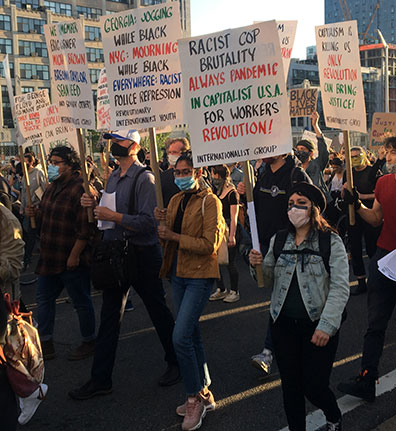 March in New York City, 31 May
2020, protesting racist cop murder of George Floyd in
Minneapolis. (Internationalist
photo)
March in New York City, 31 May
2020, protesting racist cop murder of George Floyd in
Minneapolis. (Internationalist
photo)In the early weeks of the COVID pandemic, we saw videos of police beating black people for not wearing masks on the street, while white picnic-goers were handed masks by police officers. Fresh in our minds still was how multiple cops pointed their guns into a crowded New York subway car, aiming at Adrian Napier, a black teen they were going after for supposedly jumping the turnstile. Today, New York’s Democratic mayor Eric Adams, a former NYPD captain, and Governor Kathy Hochul have deployed the state police, National Guard and an additional 800 city cops to fight a phantom “crime-wave” in the subways, in an effort to return to the “stop-and-frisk” days of the Michael Bloomberg mayoral administration.
The protests in 2020, expressing mass outrage over the murder of George Floyd, Breonna Taylor, Ahmaud Arbery and so many others, were the largest sustained protests in U.S. history. It is estimated that more than 20 million people participated. Yet the protests did not yield the revolutionary change many hoped for, as the gut-level desire so many people had to end racism was channeled into supporting Joe “Shoot ’Em in the Leg” Biden in the 2020 election. And let’s not forget the role of Bernie Sanders plus AOC and other Democratic Party “socialists” in pushing support for Biden in 2020 (and 2024).
Under Biden’s presidency, the racist cop killings have continued. This was exemplified by the brutal murder of Tyre Nichols in January 2023 by Memphis police. At Hunter College, we organized a speak-out against the murder of Tyre and of Tortuguita (Manuel Esteban Paez Terán), an activist against Atlanta’s “Cop City.” At that protest we heard a direct report from Memphis by a former member of the Black Panther and Young Lords parties and also spoke about the fight to free Mumia Abu-Jamal, the former Panther and renowned radical black journalist who has been in Pennsylvania prisons on frame-up charges for over four decades.1
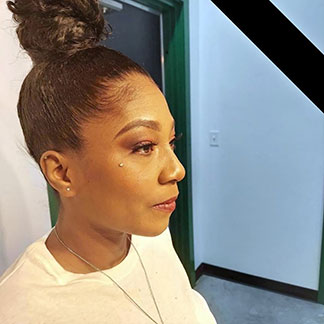 Sonya Massey (Photo: Courtesy of Ben Crump)
Sonya Massey (Photo: Courtesy of Ben Crump)What about the calls to “defund the police” that were raised by a wide range of self-described leftists, the Democratic Socialists of America and various Democratic politicians amidst the protests of 2020? These were an illusion and a deception, as we systematically explained at the time. The cops were going to keep doing their job of repression for the ruling class and “whether or not billy clubs are cheaper, they’ll still crack your head.” And in fact the eventual outcome is more funding for police departments around the country. Today, the many young people who still want to do something about racism and racial oppression are left wondering what is to be done about the society we live in – one that brings pain, despair, worry and death to millions here and around the world.
Capitalism and Racism
As Malcolm X famously said, “You can’t have capitalism without racism.” To put it another way: it’s a feature, not a bug, in this society founded on chattel slavery, in which exploitation and inequality are fundamental to the whole profit system.2 For us communists, who are committed to the struggle for a proletarian socialist revolution, we understand that this cannot be advanced without answering the question of how to achieve the liberation of black people.
For some people, the struggle is about having “black faces in high places” or “a seat at the [ruling-class] table.” At best, that reflects a misunderstanding of the roots of racism. For would-be CEOs and bourgeois politicians, it expresses the willingness to climb over the masses of black working people and be able to say “I’ve got mine.” Of course, revolutionaries stand against any kind of discrimination that would prevent African Americans, women or any other group from holding any kind of office or position, even those in the upper hierarchy of the ruling class. After the mass upheavals of the 1960s, the overwhelmingly white ruling class decided to let some black faces reach high places. Today we see many black mayors and police chiefs among the Democratic bosses of the killer cops. And we see the record of California’s former “top cop” Kamala Harris, who became the VP of Joe Biden, whose sponsorship of the 1994 “anti-crime” bill is infamous for fueling mass incarceration.
The 2008 election of the first black president, while a social change, was not a political change, and in some ways black people’s situation today is worse than half a century ago. Black liberation is so far from being achieved that many ex-radicals have given up on it. While today a lot of youth have come to the conclusion that capitalism needs to be done away with, a lot are far from clear on how that will answer the question of black liberation. The predominance of liberal/reformist identity-politics conceptions means that many think that black people gaining their full rights would actually come at the expense of average white people. This is not just false but deadly, as it is central to claims by racist ideologues. Racists say that black oppression is beneficial, not to the capitalist ruling class, but to your average white person, who supposedly stands to lose from any advance for African Americans. That is a deadly dangerous falsehood and a serious obstacle to the fight for black freedom.
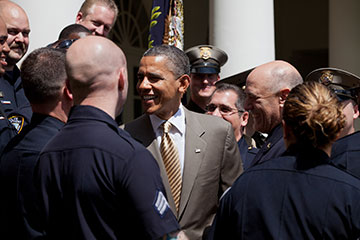 “Black faces in high places does not freedom
make,” wrote Mumia Abu-Jamal. Right: Democratic president
Barack Obama meeting National Association of Police
Organizations’ “top cops” at the White House, May
2012. (Photo: White
House)
“Black faces in high places does not freedom
make,” wrote Mumia Abu-Jamal. Right: Democratic president
Barack Obama meeting National Association of Police
Organizations’ “top cops” at the White House, May
2012. (Photo: White
House)It is striking that privilege theory, in its acceptance of capitalist ideology, agrees that it’s all a zero-sum game in which the white population has to live worse for the black population to live better. Again, that’s a damned lie, which can only help the enemies of black liberation. Marxists explain that African Americans are doubly oppressed in capitalist America, systematically excluded from basic rights deemed the norm for the majority. We fight every day against racial oppression, and all forms of oppression, and for any real advances that can be gained within this society. At the same time, we explain that the struggle for equality requires fighting for a society capable of uprooting and overcoming the whole legacy of oppression. That cannot be a society based on profit, it must be one based on fulfilling human needs – a socialist society.
Capitalism can be done away with. But this requires more than the desire for it to happen, or simply “critiquing” the way things are. It requires a program based on power. The potential power is in the hands of the multiracial working class that makes everything run and can bring capitalist production, transport and all the rest of it to a halt. This is fundamental for successful struggle against racist oppression. We have gotten a taste of this with workers’ mobilizations and other actions against racist police terror and provocations by white-supremacist and fascist groups in Portland, Oregon and elsewhere.3 To deepen and spread this requires revolutionary leadership. The other side of this same coin is that fighting for black liberation through socialist revolution is key to forging class-struggle leadership of the working class as a whole.
What Is Revolutionary Integrationism?
Forging that leadership is a serious task that requires a materialist, scientific analysis of society. Marxists reject the acceptance of today’s social conditions, of the blatant racism that we see and experience today, as something innate to “human nature,” the product of a free-floating and ahistorical “white supremacy” or expression of “whiteness,” and other fashionable liberal and/or conservative bourgeois notions.
All this reflects what Marxists call idealism, the belief that it is ideas that drive material reality. Instead, Marxists are materialists, understanding that material reality, and class interests, give rise to ideas (and underlie ideology, including that of race, and racism). Racism is rooted in the material reality of racial oppression, which arose from the profit-making mechanisms of slavery and the slave trade, as well as colonialism. It survives and is continuously reproduced today on the basis of the massive inequalities of capitalist society.
Revolutionaries put forward a program for intervening in social reality to change it. A crucial part of doing this in the U.S. involves understanding the origins and present-day workings of racial oppression – and how racist ideology arises from and serves to justify that oppression. In August 2020, amidst the nationwide mass upsurge against racist cop terror, the headline of our paper (Revolution No. 17) was: “Only Revolution Can Bring Justice.” This is an expression of our Marxist program of revolutionary integrationism, based on a materialist understanding of the nature of black oppression in the United States. Let’s start to break down what that means.
Revolutionary meaning, among other things, that we oppose all forms of liberal accommodationism to the status quo, the parties and politicians of racist U.S. capitalism. Revolutionary meaning that we are not content with reforms: while Marxists support any genuine reform, we expose the illusion that oppression can be reformed away, with the domination of the capitalist class and its state apparatus left intact. Revolutionaries’ aim is for the working class to take power, establishing a workers state opening the way for a society whose resources and technology are used to free, not subjugate, the majority. That is, a classless, stateless socialist society here and around the world.
Integrationist meaning, in part, that we look to unite the working class across the color line – the biggest obstacle to the overthrow of the capitalist system – and bring its power into the fight for black liberation. And integrationist meaning that black liberation won’t be achieved by black people somehow separating from U.S. society. There is no common territory of the African American population (approximately 14% of the overall population, concentrated in different parts of the U.S.) that would separate off and form a separate country; and “self-determination” of impoverished segregated neighborhoods is a cruel joke and illusion.
A strategy based on separation (such as black nationalism in its various incarnations) is illusory. This illusion – which arises in times of defeat and despair – cuts against the actual struggle for black freedom. Marxists, in contrast, understand that the struggle can draw immense power from African Americans’ concentration in strategic sectors of production and transport as a key (and often leading) part of the multiracial working class. Liberation requires not nationalistic fantasy scenarios but the revolutionary seizure of the whole thing, the fruits of our collective labor: the wealth and resources of this society as a whole. It is this and only this that will enable full and genuine integration, into an egalitarian socialist society.
Historical Context
Where did the program of revolutionary integrationism come from? A comrade named Richard Fraser, who was an organizer, activist and self-taught scholar in the Trotskyist movement going back to the 1930s, put it forward and coined the term amidst the rise of the civil rights movement in the 1950s.
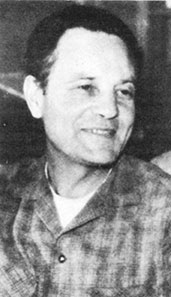 Richard Fraser
Richard FraserAfter World War Two, U.S. imperialism’s anti-Soviet Cold War plunged society into repressive political and cultural conformity. Both liberals and conservatives pushed the stifling anticommunist “Cold War consensus.” It was the civil rights movement arising in the 1950s that started breaking this up. In part this reflected sharply increased urbanization of the black population, while sectors of the ruling class saw Jim Crow – the South’s de jure (written down in laws) form of racist segregation – as a liability for U.S. claims to represent the “free world.”
In the U.S., a small but vital Trotskyist movement had been founded under the leadership of James P. Cannon, a founder of the Communist Party who, together with other cadres of the CP, opposed its degeneration under the sway of Joseph Stalin’s conservative nationalist bureaucracy in the USSR. Like Trotsky, the then-revolutionary Socialist Workers Party led by Cannon and others saw the fight for black freedom as central to revolution in the U.S. However, Dick Fraser had grown increasingly dissatisfied with the SWP’s lack of clear definition regarding the material nature of black oppression in this country. Was the oppression of African Americans similar in kind to that of subject nations in the old tsarist empire of Russia or the situation of British and French colonies, many of which gained independence in the ’50s?
A deep study of the dynamics of black freedom struggles throughout U.S. history, and of the workings of modern-day U.S. society, led Fraser to argue that no, black oppression in the U.S. is not a national question but a different, specific form of racial oppression. This was connected to his determination to help forge a program to reach both black and white workers and unite them in common struggle against exploitation and oppression under the leadership of a Leninist vanguard party. Without an accurate analysis, such a program could not emerge.
Richard Fraser’s contribution was codified first in two pioneering lectures he gave in 1953, titled “The Negro Struggle and the Proletarian Revolution,” followed in 1955 by his document “For the Materialist Conception of the Negro Struggle.”4 (“Negro” was then the generally accepted term used by African Americans.) In a short discussion, we can only touch on some aspects, but a striking one is Fraser’s discussion of “the origin of the race concept.” This was decades before the education system began teaching the scientific fact that race is a biological fiction. As a Marxist, back in 1953 Fraser highlighted that fact and answered the question: Where does race ideology come from? It emerged from the formation of a class, which came to be marked off by skin color, that was essential to massive plantation agriculture. The labor of that class, the chattel slaves, was key to the rise of U.S. capitalism. Bourgeois liberals think the idea – racism – caused the material reality of racial oppression. In reality, the material reality created the ideology.
After the Civil War defeated the Southern slave owners, Reconstruction was sold out by the Northern bourgeoisie.5 The ideology of race continued to serve to justify the bitter social reality of ongoing inequality and oppression. As time went on. conscious purveyors of racist vileness obviously did their part. But a central point is that the ongoing material reality of racial oppression continually generates racist ideology. For this to end, as Fraser stressed, we have to transform that material reality. Program is a guide to action in that struggle.
Worn down by the effects of the McCarthyite witch hunt, the SWP was increasingly pessimistic about its ability to provide revolutionary leadership and actually change society. It evaded – as so many left groups do today – the responsibility to provide a clear materialist analysis of the nature of black oppression. Instead, the SWP took refuge in vague hypotheses about how a black nation might supposedly emerge at some time.6 This was convenient for tailing liberal civil rights leaders and the black nationalist mood that arose in the ’60s in reaction to the civil rights movement’s defeats when it came up against the de facto segregation prevalent in the North.
Within the SWP, a left opposition called the Revolutionary Tendency (RT) challenged the party’s opportunist course. Expelled in 1963-64, it established the Spartacist tendency, which upheld the Trotskyist program for the following three decades. The RT’s embrace of Fraser’s revolutionary integrationism is an important part of the heritage of the Internationalist Group and its youth section, the Revolutionary Internationalist Youth. As our comrades wrote after Obama’s election, when most of the left helped push illusions that “black faces in high places” really did mean “hope and change”:
“As opposed to conservative accommodation and liberal integrationism, we Trotskyists fight for a program of revolutionary integrationism. We stress that the fight for black freedom and equality in capitalist America can only succeed by overturning the economic foundations of black oppression. We recognize the radical impulse of many black nationalists who were breaking from the liberal preachers, but emphasize that the oppressed black poor and working people can only achieve power through common struggle together with their class sisters and brothers of all races. We stand for black liberation through socialist revolution.”7
“We’re Going to Fight Racism with Solidarity”
When young radicals today learn about the growth of black radicalism in the 1960s, our attention is often drawn to those who, seeking a revolutionary road, courageously upheld the right of armed self-defense and denounced “official” civil rights leaders’ support to the Democratic Party. Among the most heroic were brothers and sisters in the Black Panther Party (BPP), which faced the murderous rage of the ruling class which used the FBI’s COINTELPRO program to kill or jail large numbers of Panthers.
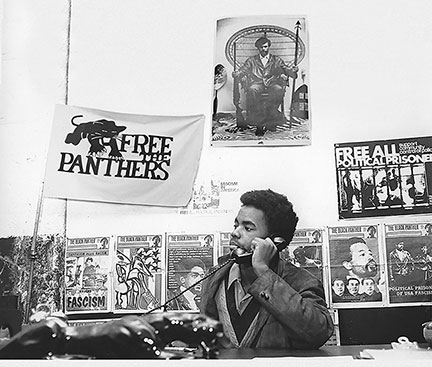 Mumia Abu-Jamal was minister of
information of the Philadelphia Black Panther Party in
1968-69. (Photo: Philadelphia
Enquirer)
Mumia Abu-Jamal was minister of
information of the Philadelphia Black Panther Party in
1968-69. (Photo: Philadelphia
Enquirer)Assata Shakur and Mumia Abu-Jamal are two former Panthers who survived, though Assata had to take refuge in Cuba, where she still lives, and Mumia has been imprisoned since his 1982 frame-up trial. (Mumia wrote about his experiences in the BPP in his book We Want Freedom: A Life in the Black Panther Party [1982].) Two of the many Panthers who did not survive the deadly COINTELPRO onslaught were young Chicago Panther leaders Fred Hampton and Mark Clark, assassinated by the Chicago PD in an FBI-organized predawn hit job in December 1969.
Fred Hampton was 21 years old. The most famous quotation from him comes from a speech several months prior to his murder:
“You’ve got to stop identifying people with being your brothers because they’ve got the same color skin you have … and you’ve got to stop getting hung up in a whole race question because this is a class struggle. It’s a class struggle whether we want to face it or not. The Black Panther Party hears a lot of people saying, ‘Let’s go ahead and fight fire with fire.’ But we say ‘No!’ We may be in the minority, but this minority is going to keep shouting loud and clear, ‘We’re not going to fight fire with fire, we’re going to fight fire with water. We’re not going to fight racism with racism, we’re going to fight racism with solidarity. We’re not going to fight capitalism with black capitalism, we’re going to fight capitalism with socialism’.”
This was intended as a critique of what he viewed as “narrow” (or “porkchop”) nationalism. Hampton sought to challenge the go-it-alone separatist outlook as well as those buying into “black capitalism” schemes, which then-president Richard Nixon was actually promoting. His revolutionary potential cut short by police bullets, the talented young Chicago Panther leader had not arrived at a thorough-going break with the sectoralist outlook embedded in the BPP’s program, with each oppressed group fighting for its own liberation (“Black Power for black people, Puerto Rican power for Puerto Rican people,” etc.). He envisaged a kind of loose federation among the various sectors rather than a multiracial proletarian vanguard party.
Today, revolutionary integrationism is a program that we in the Revolutionary Internationalist Youth and CUNY Internationalist Clubs are determined to help put into practice. Together with Internationalist supporters in the labor movement, we call for building workers defense guards based on union power, to stop fascist and white-supremacist attacks. We educate revolutionary-minded students about the potential of labor’s power indicated by the shutdowns of West Coast ports for Mumia’s freedom and in protest against the murder of George Floyd. Revolutionaries tie this to our call to break with the Democrats, Republicans and all capitalist parties and politicians – more crucial than ever as the election season ramps up demands that workers and youth line up as voting cattle for the imperialist war criminals.
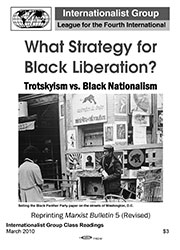 Internationalist
Readings, What Strategy for Black Liberation?
includes Richard Fraser’s “For the Materialist Conception of
the Negro Question,” and much more. Reprinting Marxist
Bulletin No. 5 (Revised) of the then-revolutionary
Spartacist League. To order a copy, write to Mundial
Publications, Box 3321, Church Street Station, New York, NY
10008, USA. Price: US$5 including shipping
Internationalist
Readings, What Strategy for Black Liberation?
includes Richard Fraser’s “For the Materialist Conception of
the Negro Question,” and much more. Reprinting Marxist
Bulletin No. 5 (Revised) of the then-revolutionary
Spartacist League. To order a copy, write to Mundial
Publications, Box 3321, Church Street Station, New York, NY
10008, USA. Price: US$5 including shipping Our program has a very different class orientation than that of those pushing one or another phony facelift for this racist society. The counterposed approaches are directed to opposite social classes. Liberals and reformists look to convince and pressure the capitalist ruling class, while Marxist revolutionaries work to awaken and mobilize the multiracial working class to realize and utilize its own power to sweep away the capitalist system and open the way to a society without oppression. Revolutionary integrationism is an essential part of the program for workers revolution. ■
- 1. See articles on racist police terror, “Cop City” and the fight to free Mumia Abu-Jamal in Revolution No. 20, September 2023 and The Internationalist No. 69-70, January-May 2023.
- 2. See “Slavery, Race, and Ideology in the United States of America,” in Karen E. Fields and Barbara J. Fields, Racecraft: The Soul of Inequality in American Life (2012), which emphasizes that to understand “race,” one must understand its functions as an ideology arising historically (and in present-day society) from material conditions.
- 3. See “Portland Labor Mobilizes to Stop Fascist Provocation,” The Internationalist No. 48, May-June 2017.
- 4. Published in the SWP’s Discussion Bulletin in August 1954 and August 1955, respectively.
- 5. See “The Emancipation Proclamation: Promise and Betrayal,” The Internationalist No. 34, March-April 2013.
- 6. Cannon indicated his disquiet with this in his important 1959 talk “The Russian Revolution and the American Negro Movement” (reprinted as an Internationalist Group pamphlet).
- 7. “Barack Obama vs. Black Liberation,” The Internationalist No. 28, March-April 2009. Debates in the Trotskyist movement that led to Fraser’s analysis are discussed in a useful article, “In Defense of Revolutionary Integrationism,” published in Spartacist (Winter 1993-94) when it still upheld the Trotskyist program.
